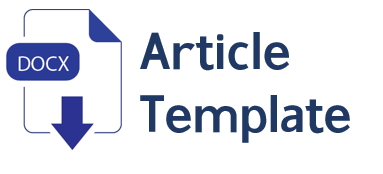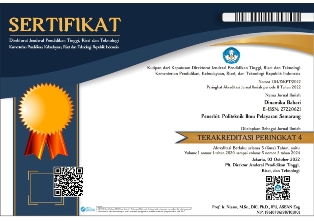The Effectiveness of Computer-Based Monitoring and Evaluating Vessel Inventory List for Human Resource Performance
Abstract
The urgency of this research is how a company is able to obtain better of HR performance, develop knowledge, improve service quality and can create competitiveness for the company. This study objective is to describe whether quality knowledge can encourage technical superintendent motivation so that it can improve technical superintendent work performance during monitoring and evaluation of inventory on board using computer-based applications and knowing quality knowledge can improve technicalsuperintendent work performance so as to realize the performance of monitoring and evaluation of inventory list on board effectively. The method used in this study is the explanatory method. Data collection was carried out online from the distributed instruments. The target population in this study were employees in the fleet division at 7 (seven) shipping companies which were used as research objects with a total number of employees of 160 employees. The data obtained is then tabulated, then data reduction is carried out and after obtaining proper data, calculations are carried out using the SPSS application by carrying out validity tests, variable reliability tests, normality tests and homogeneity tests. According to the results, it is known that there is a strength relationship between the knowledge quality and human resources performance.
Downloads
References
Ahbabi, S. A. Al, Singh, S. K., Balasubramanian, S., & Gaur, S. S. (2019). Employee perception of impact of knowledge management processes on public sector performance. Journal of Knowledge Management, 23(2), 351–373.
Amit, R., & Schoemaker, P. J. (1993). Strategic assets and organizational rent. Strategic management journal, 14(1), 33-46.
Barney, J. (1991). Firm Resource and Sustained Competitive Advantage. Journal of Management, 17(1), 99–120.
Barney, J. B. (1995). Looking inside for competitive advantage. Academy of Management Perspectives, 9(4), 49-61.
Durcikva, A., & Gray, P. (2009). How Knowledge Validation Processes Affect Knowledge Contribution. Journal of Management Information Systems, 25(4), 81–107.
Felicio, A., Couto, E., & Caiado, J. (2012). Human Capital and Social Capital in Entrepreneursand Managers of Small and Medium Enterprises. Journal of Business Economics and Management, 13(3), 395–420.
Gansiniec, L. R. (2019). Organizational Learning in Industry 4.0. Problemy ZarzÈdzania – Management Issues, 17(2 (No 82)).
Hair, J. F., Black, W. C., & Babin, B. J. (2010). Multivariate Data Analysis-A Global Perspective (7th ed.). Perason.
Hoskinson. (2001). Ray Bradbury’s Cold War Novels. In H. Bloom (Ed.), Modern Critical Views: Ray Bradbury. Chelsea House.
Hosmani, & Shambhushankar, B. R. (2014). Study on Impact of Quality of Work Life on Job Performance amongst Employees of Secunderabad Division of South Central Railway. Research Journal of Management Sciences, 3(8), 8–11.
Kamukama, N. (2013). Intellectual capital: company's invisible source of competitive advantage. Competitiveness Review: An International Business Journal, 23(3), 260-283.
Kor, Y. Y., & Mahoney, J. T. (2004). Edith Penrose's (1959) contributions to the resource‐based view of strategic management. Journal of Management Studies, 41(1), 183-191.
Longshore, J. M. (1987). Leadership and Performance Beyond Expectation. Academy of Management Review, 12(4).
Mangkunegara. (2001). Manajemen Sumber Daya Manusia Alih Bahasa. Salemba Empat.
Marquardt. (1996). Building The Learning Organization, A systems Approach toQuantum Improvement and Global Success. McGraw-Hill.
Massaro, M., Dumay, J., Garllaty, A., & Mas, francesca D. (2018). Practitioners’ views on intellectual capital and sustainability: From a performance-based to a worth-based perspective. Journal of Intellectual Capital, 19(2), 367-386
Neta, R., & Pitchard, D. (2009). Arguing about Knowledge. Routledge.
Nurdin, D. (2018). Analysis of Supervision for The Implementation of International Safety Management Code on The hipping Company. Advances in Transportation and Logistics Research, 1, 1415-14.
Pertiwi, F. N. (2021). Dimensi pengetahuan FKPM (faktual, konseptual, prosedural, dan metakognitif) mahasiswa IPA pada pembelajaran mekanika. Jurnal Ibriez: Jurnal Kependidikan Dasar Islam Berbasis Sains, 6(1), 111-124.
Rivai, F., Basri, A. Fawzi M., & Murni, S. (2005). Performance Appraisal: Sistem yang tepat untuk menilai kinerja karyawan dan meningkatkan daya saing perusahaan. PT. Raja Grafindo Persada.
Riyoko, S., Hendar, & Widodo. (2022). Grand Theory Model “Antidenden Enenrgizing Profesional Networks dan Konsekuensi Terhadap Kinerja Pemasaran” (1 ed.). Lakeisha.
Rugman, Alan M., and Alain Verbeke. "A final word on Edith Penrose." Journal of Management Studies 41.1 (2004): 205-217.
Lusri, L. (2017). Pengaruh motivasi kerja terhadap kinerja karyawan melalui kepuasan kerja sebagai variabel mediasi pada karyawan PT. Borwita Citra Prima Surabaya. Agora, 5(1).
Sukma, A. (2018). Perspektif the resource based view (RBV) dalam membangun competitive advantage. Ad-Deenar: Jurnal Ekonomi Dan Bisnis Islam, 1(1), 75-89.
Sulastri. (2019). Pengembangan Organisasi Pada PT Taspen (Persero) Analisis Menggunakan Teori Model Sistem Organisasi Pembelajar dari Marquardt (1996).
Suryadi, E. (2010). Analisis Peranan Leadership Dan Budaya Organisasi Terhadap Kinerja Pegawai. Manajerial: Jurnal Manajemen dan Sistem Informasi, 9(1), 1-9.
Sutono, E. (2016). Analisi Tugas Ssupervisor Dalam Mengevaluasi Kinerja Pada Karyawan di PT. Anugrah Mandiri Karya Bersama Jakarta Barat. Ekuilibrium, 3(6).
Teece, D. J., Pisano, G., & Shuen, A. (1997). Dynamic capabilities and strategic management. Strategic management journal, 18(7), 509-533.
Wernerfelt, B. (1984). A resource‐based view of the firm. Strategic Management Journal, 5(2), 171-180.
Wright, D., Foster, C., Amir, Z., Elliott, J., & Wilson, R. (2010). Critical appraisal guidelines for assessing the quality and impact of user involvement in research. Health Expectations, 13(4), 359-368.
Yoo, D. K., A, V., & Ragu, N. T. . (2011). Knowledge quality: antecedents and consequence in project teams. Journal of Knowledge Management, 15(2), 329–343.














